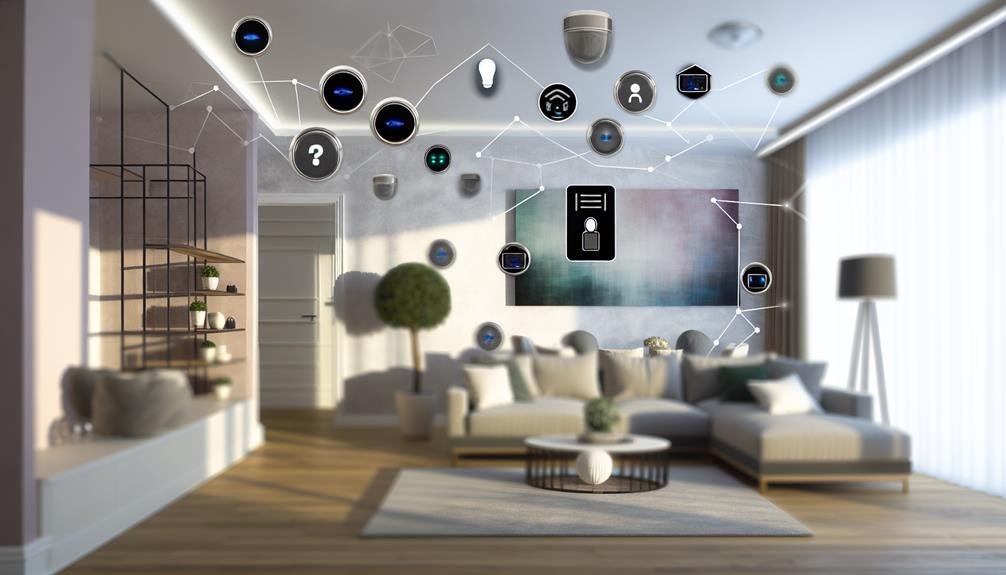Are you tired of manually controlling every aspect of your home? Imagine a world where your home knows exactly what you need before you even realize it. Well, thanks to the incredible advancements in technology, this is now possible with the use of sensors in smart home automation.
From enhancing security to improving energy efficiency, sensors play a crucial role in creating a seamless and intelligent living environment.
But how do these sensors work? What are the different types available? And what benefits can they bring to your everyday life?
Let's explore the fascinating world of sensors in smart home automation and uncover the limitless possibilities they offer.
Key Takeaways
- Sensors play a crucial role in various aspects of smart home automation, including irrigation, touchless control, security, energy efficiency, lighting, and climate control.
- Motion sensors offer benefits such as instant alerts, flexibility in installation, automation of other home aspects, creating a deterrent effect, and integration with security systems.
- Temperature sensors contribute to energy efficiency by continuously monitoring and controlling heating and cooling systems, identifying temperature variations, integrating with smart thermostats, reducing energy waste, and ensuring comfort while minimizing consumption.
- Light sensors enable automatic adjustment of lighting levels, daylight harvesting, integration with motion sensors, dimming or turning off lights when no motion is detected, and enhancing aesthetics and energy efficiency in outdoor spaces.
Types of Sensors in Smart Home Automation
In smart home automation, various types of sensors play a crucial role in monitoring and controlling the environment for enhanced efficiency and convenience.
Two important types of sensors used in smart home automation are soil moisture sensors for smart irrigation systems and proximity sensors for touchless control of appliances.
Soil moisture sensors are designed to measure the moisture level in the soil. They're essential for smart irrigation systems as they help optimize water usage by providing real-time data on soil moisture. With the help of these sensors, homeowners can ensure that their lawns and gardens receive the right amount of water, preventing overwatering and saving water resources.
Proximity sensors, on the other hand, enable touchless control of appliances in a smart home. These sensors detect the presence or absence of a person and trigger actions accordingly. For example, when someone approaches a door, the proximity sensor detects their presence and automatically opens the door. Similarly, in the kitchen, proximity sensors can be used to turn on or off appliances without the need for physical contact, making cooking and meal preparation more convenient and hygienic.
How Motion Sensors Improve Home Security
Motion sensors play a crucial role in enhancing home security by detecting movement and triggering appropriate actions. Wireless motion sensors have become an integral part of modern security systems, providing homeowners with a reliable and efficient way to protect their homes. These sensors use different technologies, such as infrared or microwave, to detect changes in the environment and identify potential threats.
By integrating motion sensors with security systems, homeowners can receive instant alerts on their smartphones or other connected devices whenever motion is detected in or around their homes. This allows them to take immediate action, whether it's contacting the authorities or simply checking the security camera feed to assess the situation.
One of the key benefits of wireless motion sensors is their flexibility and ease of installation. Unlike traditional wired sensors, which require complex wiring, wireless sensors can be easily placed in any desired location without the need for extensive modifications to the home. This makes them ideal for both homeowners and renters who want to enhance their home security without the hassle of a complex installation process.
In addition to detecting intruders, motion sensors can also be used to automate other aspects of the home, such as turning on lights or adjusting the thermostat when someone enters a room. This not only improves convenience but also creates the illusion that someone is always present in the home, deterring potential burglars.
The Role of Temperature Sensors in Energy Efficiency
Temperature sensors play a crucial role in optimizing energy efficiency in smart homes. By continuously monitoring the temperature, these sensors enable efficient control of heating and cooling systems, resulting in reduced energy consumption and cost savings.
Energy consumption monitoring is a key feature of temperature sensors. They provide real-time data on the temperature in different areas of the home, allowing homeowners to identify areas that may be over or underheated. With this information, adjustments can be made to optimize heating and cooling, ensuring that energy is only used where and when it's needed.
Optimizing heating and cooling is another important function of temperature sensors. These sensors can be integrated with smart thermostats, allowing for precise control of temperature settings based on occupancy and time of day. For example, the sensors can detect when a room is unoccupied and adjust the temperature accordingly, reducing energy waste. Additionally, they can learn the preferences of the occupants and automatically adjust the temperature to ensure comfort while minimizing energy consumption.
Using Light Sensors for Smart Lighting Solutions
Light sensors are essential components in smart lighting solutions, allowing for automatic adjustment of lighting levels based on ambient light conditions. These sensors play a crucial role in maximizing energy efficiency and creating a comfortable lighting environment for both indoor and outdoor applications.
In outdoor settings, light sensors are used for daylight harvesting, a technique that utilizes natural light to reduce the need for artificial lighting. By detecting the amount of natural light available, the sensors can adjust the intensity of outdoor lighting accordingly. This not only saves energy but also enhances the aesthetics of outdoor spaces.
Daylight harvesting is particularly beneficial in areas like gardens, patios, and parking lots, where the lighting requirements often vary throughout the day. Light sensors can detect changes in natural light levels and automatically adjust the brightness of outdoor lighting fixtures, ensuring optimal visibility and safety.
Additionally, light sensors can be integrated with other smart home automation systems to provide advanced functionality. For example, they can work in tandem with motion sensors to activate outdoor lighting when someone approaches, and then dim or turn off the lights when no motion is detected.
Enhancing Comfort With Sensor-Based Climate Control
To create an optimal and comfortable living environment, sensor-based climate control systems are employed in smart homes. These systems use a variety of sensors to monitor and adjust the temperature, humidity, and air quality inside the house. By doing so, they can ensure that the conditions are always at their most comfortable levels, enhancing your overall comfort and well-being.
One of the key benefits of sensor-based climate control is its ability to optimize energy consumption. By constantly monitoring the environmental conditions and occupancy patterns, the system can adjust the heating, cooling, and ventilation accordingly, ensuring that energy is not wasted on empty rooms or unnecessary temperature adjustments. This not only reduces energy costs but also promotes sustainability.
To give you a better understanding, here is an example of a sensor-based climate control system and its corresponding features:
| Sensor | Purpose |
|---|---|
| Temperature Sensor | Monitors and adjusts the temperature inside the house based on your preferences. |
| Humidity Sensor | Maintains the ideal humidity level, preventing dryness or excessive moisture. |
| CO2 Sensor | Monitors the carbon dioxide levels and ensures proper ventilation to maintain air quality. |
| Occupancy Sensor | Detects the presence of occupants and adjusts the temperature accordingly to avoid wasting energy. |
With sensor-based climate control, you can enjoy a comfortable living environment while optimizing energy consumption and promoting air quality control. It's a win-win situation that enhances your overall comfort and contributes to a more sustainable and efficient home.






